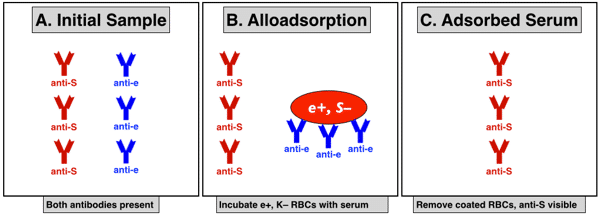Glossary
Alloadsorption
Alloadsorption (also called “differential adsorption”) is an advanced blood banking technique designed to remove certain antibodies from a patient serum that contains multiple antibodies (contrast “autoadsorption“). Here’s a simple example (see image below): Imagine that a blood banker is trying to identify what seems to be multiple unexpected (non-ABO) antibodies. The blood banker suspects that anti-e and anti-S are present, but the overall pattern is not clear. In order to confirm her suspicions, she could mix the patient’s plasma with RBCs from an e-positive, S-negative person. The suspected anti-e would be expected to bind (adsorb) to the surface of those red cells, while the suspected anti-S would remain in the plasma. Following the alloadsorption, the tech would centrifuge the serum left behind (the “adsorbed serum“) and identify any antibodies present, revealing (if all worked as expected) a straightforward anti-S. Incidentally, the red cell portion of the mixture could then undergo an elution in order to identify the anti-e bound to the surface of the red blood cells.

Back to Glossary List

